英语基础模块第二版第二册Unit_1
- 格式:ppt
- 大小:13.23 MB
- 文档页数:67
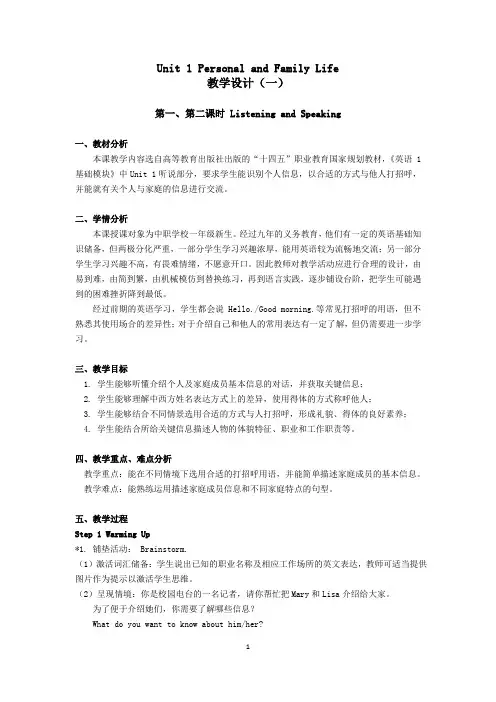
Unit 1 Personal and Family Life教学设计(一)第一、第二课时 Listening and Speaking一、教材分析本课教学内容选自高等教育出版社出版的“十四五”职业教育国家规划教材,《英语1 基础模块》中Unit 1听说部分,要求学生能识别个人信息,以合适的方式与他人打招呼,并能就有关个人与家庭的信息进行交流。
二、学情分析本课授课对象为中职学校一年级新生。
经过九年的义务教育,他们有一定的英语基础知识储备,但两极分化严重,一部分学生学习兴趣浓厚,能用英语较为流畅地交流;另一部分学生学习兴趣不高,有畏难情绪,不愿意开口。
因此教师对教学活动应进行合理的设计,由易到难,由简到繁,由机械模仿到替换练习,再到语言实践,逐步铺设台阶,把学生可能遇到的困难挫折降到最低。
经过前期的英语学习,学生都会说Hello./Good morning.等常见打招呼的用语,但不熟悉其使用场合的差异性;对于介绍自己和他人的常用表达有一定了解,但仍需要进一步学习。
三、教学目标1. 学生能够听懂介绍个人及家庭成员基本信息的对话,并获取关键信息;2. 学生能够理解中西方姓名表达方式上的差异,使用得体的方式称呼他人;3. 学生能够结合不同情景选用合适的方式与人打招呼,形成礼貌、得体的良好素养;4. 学生能结合所给关键信息描述人物的体貌特征、职业和工作职责等。
四、教学重点、难点分析教学重点:能在不同情境下选用合适的打招呼用语,并能简单描述家庭成员的基本信息。
教学难点:能熟练运用描述家庭成员信息和不同家庭特点的句型。
五、教学过程Step 1 Warming Up*1. 铺垫活动: Brainstorm.(1)激活词汇储备:学生说出已知的职业名称及相应工作场所的英文表达,教师可适当提供图片作为提示以激活学生思维。
(2)呈现情境:你是校园电台的一名记者,请你帮忙把Mary和Lisa介绍给大家。
为了便于介绍她们,你需要了解哪些信息?What do you want to know about him/her?提供选项:姓名、职业、工作单位、年龄、体貌特征、兴趣爱好等。

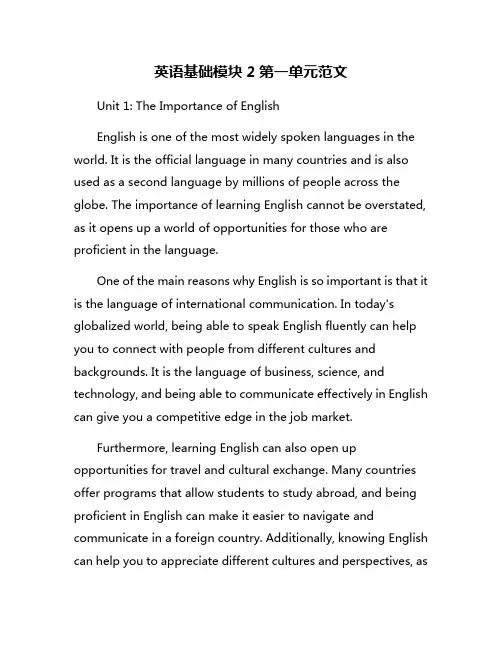
英语基础模块2第一单元范文Unit 1: The Importance of EnglishEnglish is one of the most widely spoken languages in the world. It is the official language in many countries and is also used as a second language by millions of people across the globe. The importance of learning English cannot be overstated, as it opens up a world of opportunities for those who are proficient in the language.One of the main reasons why English is so important is that it is the language of international communication. In today's globalized world, being able to speak English fluently can help you to connect with people from different cultures and backgrounds. It is the language of business, science, and technology, and being able to communicate effectively in English can give you a competitive edge in the job market.Furthermore, learning English can also open up opportunities for travel and cultural exchange. Many countries offer programs that allow students to study abroad, and being proficient in English can make it easier to navigate and communicate in a foreign country. Additionally, knowing English can help you to appreciate different cultures and perspectives, asit allows you to access a wide range of literature, films, and music from around the world.In conclusion, learning English is essential in today's world. It can help you to communicate with people from different backgrounds, access a wealth of information and opportunities, and broaden your horizons. Whether you are a student, a professional, or simply someone who is interested in the world around you, learning English is a valuable skill that can enrich your life in countless ways.。
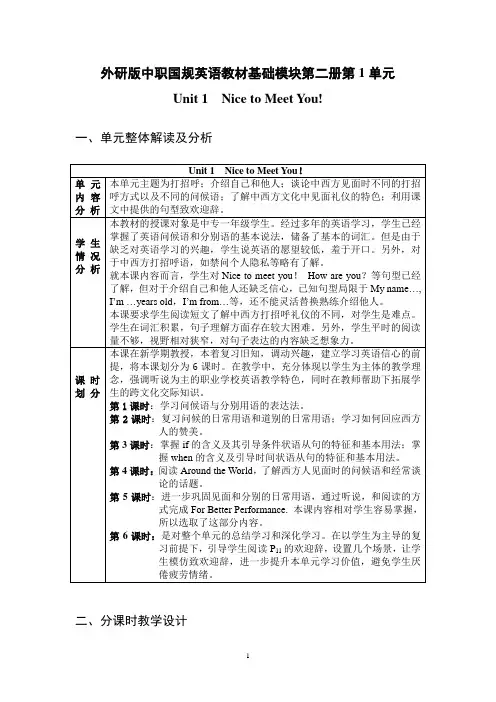

《英语》(基础模块)(修订版)第二册第一单元-CAL-FENGHAI.-(YICAI)-Company One1外研版基础模块(修订版)第二册Unit 1 Nice to meet you! 一、单元整体解读及分析二、分课时教学设计第一课时时间环节意图3’导入一、师生互动二、教师随机提问:Who was the first one yougreet in the school this morningWhat did you say教师把回答板书在黑板上。
集体回答。
个别回答。
拉近师生距离,迅速进入主题。
38’听说练习Pre-listening:1)头脑风暴:We have met many familiars. NowI will introduce a new comer David toyou. Let’s say something tohim.教师展示图片。
并把学生的回答写在黑板上。
注意书写位置要便于下一环节的归类。
已有的内容直接在板书上划出来。
2)角色扮演:教师请学生两人一组,借鉴板书上的句型,完成和David的对话。
教师把学生使用的新句型写在黑板上。
学生举手回答。
学生准备两分钟后和搭档们进行对话,教师将选择其中三组上台作“角色扮演”。
“头脑风暴”的意图有两个:一是为了让学生联想起大脑中已储存的“寒暄”句型。
为下一步的听力作准备。
二是为活动③Listenagain and act中的句型拓展作铺垫。
“角色扮演”的意图有两个:一是通过对话对听力材料进行预设,降低学生对听力练习的焦虑。
二是拓展句型,丰富活动③Listen againand act环节学生输出时的语While-listening:1)“拼图”①播放录音第一遍Tell me what you hear in the dialogue. Any word, phrase, or sentence is good.教师把学生回答的内容写在黑板上,板书时要注意有意识地按照课文顺序进行书写。

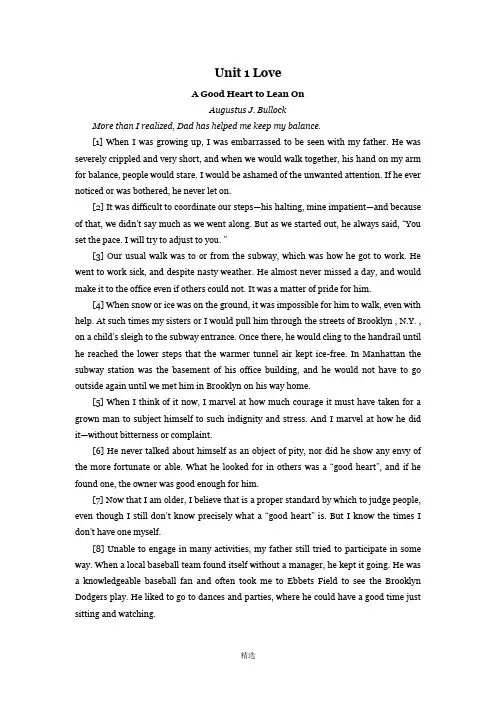
Unit 1 LoveA Good Heart to Lean OnAugustus J. BullockMore than I realized, Dad has helped me keep my balance.[1] When I was growing up, I was embarrassed to be seen with my father. He was severely crippled and very short, and when we would walk together, his hand on my arm for balance, people would stare. I would be ashamed of the unwanted attention. If he ever noticed or was bothered, he never let on.[2] It was difficult to coordinate our steps—his halting, mine impatient—and because of that, we did n't say much as we went along. But as we started out, he always said, “You set the pace. I will try to adjust to you. ”[3] Our usual walk was to or from the subway, which was how he got to work. He went to work sick, and despite nasty weather. He almost never missed a day, and would make it to the office even if others could not. It was a matter of pride for him.[4] When snow or ice was on the ground, it was impossible for him to walk, even with help. At such times my sisters or I would pull him through the streets of Brooklyn , N.Y. , on a child's sleigh to the subway entrance. Once there, he would cling to the handrail until he reached the lower steps that the warmer tunnel air kept ice-free. In Manhattan the subway station was the basement of his office building, and he would not have to go outside again until we met him in Brooklyn on his way home.[5] When I think of it now, I marvel at how much courage it must have taken for a grown man to subject himself to such indignity and stress. And I marvel at how he did it—without bitterness or complaint.[6] He never talked about himself as an object of pity, nor did he show any envy of the more fortunate or able. What he looked for in others was a “good heart”, and if he found one, the owner was good enough for him.[7] Now that I am older, I believe that is a proper standard by which to judge people, even though I still don't know precisely what a “good heart” is. But I know the times I don't have one myself.[8] Unable to engage in many activities, my father still tried to participate in some way. When a local baseball team found itself without a manager, he kept it going. He was a knowledgeable baseball fan and often took me to Ebbets Field to see the Brooklyn Dodgers play. He liked to go to dances and parties, where he could have a good time just sitting and watching.[9] On one memorable occasion a fight broke out at a beach party, with everyone punching and shoving. He wasn't content to sit and watch, but he couldn't stand unaided on the soft sand. In frustration he began to shout, “I'll fight anyone who will sit down with me! I'll fight anyone who will sit down with me! ”[10] Nobody did. But the next day people kidded him by saying it was the first time any fighter was urged to take a dive even before the bout began.[11] I now know he participated in some things vicariously through me, his only son. When I played ball (poorly), he “played” too. When I joined the Navy, he “joined” too. And when I came home on leave, he saw to it that I visited his office. Introducing me, he was really saying, “This is my son, but it is also me, and I could have done this, too, if things had been different. ” Those words were never said aloud.[12] He has been gone many years now, but I think of him often. I wonder if he sensed my reluctance to be seen with him during our walks. If he did, I am sorry I never told him how sorry I was, how unworthy I was, how I regretted it. I think of him when I complain about trifles, when I am envious of another's good fortune, when I don't have a “good heart”.[13] At such times I put my hand on his arm to regain my balance, and say, “You set the pace. I will try to adjust to you.”善良之心,久久相依当时我没有意识到,是爸爸帮我保持平衡奥古斯塔斯• J •布洛克1 随着我渐渐长大,当别人看见我和爸爸在一起,我会觉得很尴尬。
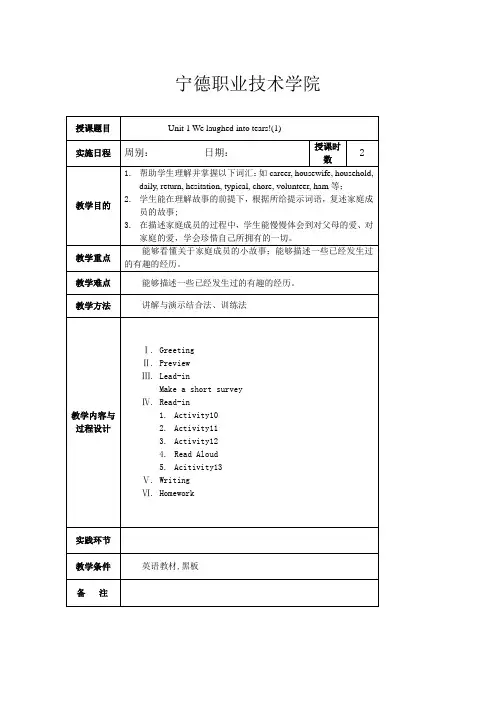
宁德职业技术学院教学过程与内容:Ⅰ. GreetingⅡ. Preview本单元是学生第二学期的第一单元,话题与学生的假期活动相关。
而学生刚从假期中归来,仍沉浸在假期的快乐中。
第一单元的话题非常符合学生的兴趣和当时的心情,这为本单元的学习打下了良好的基础。
第一单元的教学内容主要为:能够听懂并谈论假期中的活动;能够看懂关于家庭成员的小故事;能够描述一些已经发生过的有趣的经历;能够掌握并运用一般过去时的肯定式和否定式;能够在朗读时注意句子中的重读音节。
本单元的话题虽然亲切,教师仍然要注意运用多种教学手段,并关注每一个学生,在一些教学步骤中采用分层设计,帮助学生达成教学目标。
Ⅲ. Lead In(设计意图:把活动9的问题进行补充,多方面的问题能够让学生慢慢回忆起家庭中的各种趣事,从而会在下面的阅读中引起共鸣。
可以叫几个学生做一个简短的汇报,必定会引起其他同学的笑声不断。
本课时的教学即能在欢快轻松的氛围中展开。
)Ⅳ. Read-in1. Activity 10: fast reading. Get the Ss to read the letters as quickly as they can and tick the right topic. Then check the answer with the whole class.(设计意图,这一教学活动要求学生抓住重点,培养他们快速捕捉信息的能力。
)2. Activity 11. Read the letter again and tick the things Bob’s mother and Ben’s father did.(设计意图,找出课文中的关键活动,初步理解课文。
)3. Activity 12. Read the letters again and tick the correct sentences. Then check the answers with the Ss. See if they have any problems, help them with some important and difficult points.(设计意图,通过找出正确的句子让学生进一步理解课文,同时在与学生校对答案时看他们是否存在阅读障碍,讲解重点词组。
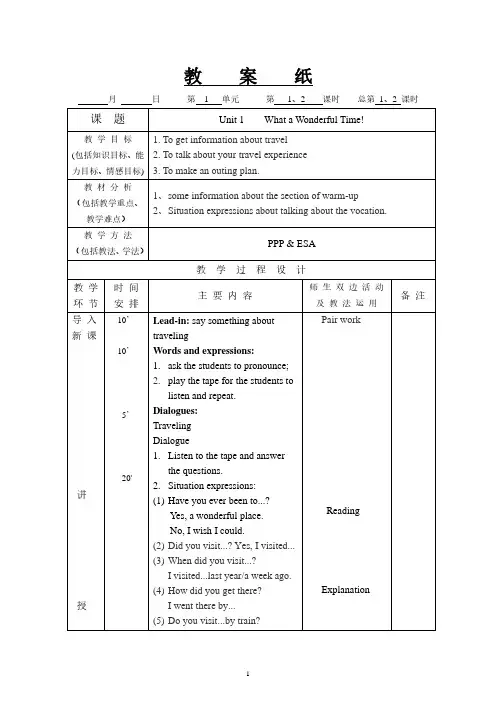
月日第 1 单元第1、2 课时总第1、2 课时课题Unit 1 What a Wonderful Time!教学目标(包括知识目标、能力目标、情感目标)1. To get information about travel2. To talk about your travel experience3. To make an outing plan.教材分析(包括教学重点、教学难点)1、some information about the section of warm-up2、Situation expressions about talking about the vocation.教学方法(包括教法、学法)PPP & ESA教学过程设计教学环节时间安排主要内容师生双边活动及教法运用备注导入新课讲授10’10’5’20'Lead-in: say something abouttravelingWords and expressions:1.ask the students to pronounce;2.play the tape for the students tolisten and repeat.Dialogues:TravelingDialogue1.Listen to the tape and answerthe questions.2.Situation expressions:(1)Have you ever been to...?Yes, a wonderful place.No, I wish I could.(2)Did you visit...? Yes, I visited...(3)When did you visit...?I st year/a week ago.(4)How did you get there?I went there by...(5)Do you visit...by train?Pair workReadingExplanation环节安排主要内容及教法运用备注新课归纳总结布置作业15’5’5’10’5’5’No, I visited the place on foot..(6) How do you like it?exciting...nguage points:(1)a bit(2)no matter(3)go wrong(4)admission ticket4.Practice: finish the chartfinish the dialogue5.Practice the dialogues in pairs.6.Make dialogues about travelingAct out the dialogues in pairs.Sum up:1.Situation expressions;nguage pointsAssignment:1.Read the new words anddialogues;2.Make a dialogue abouttraveling.HomeworkExplanationPracticeWritingOral考勤见教学日志教学体会(教学环节一般包括复习旧课、导入新课、讲授新课、学生操作、教师点评、归纳总结、布置作业等)月日第 1 单元第3、4 课时总第3、4 课时课题Unit 1 what a wonderful time!教学目标(包括知识目标、能力目标、情感目标)1、To learn the passage.2、To understand the passage.教材分析(包括教学重点、教学难点)1、Words and expressions;2、Situation expressions.教学方法(包括教法、学法)PPP & ESA教学过程设计教学环节时间安排主要内容师生双边活动及教法运用备注复习讲授15’10’5’15’5’Review:1. Read and identify new words;2. Act out the dialogues that theymade.Words and expressions:1. Ask the students to pronounce;2. Play the tape for the students tolisten and repeat.Passage:1. Pre-reading questions;2. Listen to the tape and answer thequestions;3. Situation questions:(1) We didn't prepare well for thetrip.(2)We left our flight ticket at home.(3) We were lucky that the fire atthe hotel was put out soon.(4)The bad experience didn't ruinour holiday after all.Pair workOralReadingExplanation环节安排主要内容及教法运用备注新课归纳总结布置作业20’10’5’5’4. Language points:(1)prepare for(2)no matter(3)go wrong(4)arrive at(5)fall asleep(6)put out(7)in time(8)be determined to(9)at the hotel(10)in time5. Read the passage and askquestions.Sum up:1. Situation expressions;2. Words and structures.Assignment:.Read the new words and passageHomeworkExplanationPracticeWritingOral考勤见教学日志教学体会(教学环节一般包括复习旧课、导入新课、讲授新课、学生操作、教师点评、归纳总结、布置作业等月日第 1 单元第5、6 课时总第5、6 课时课题Unit 1 what a wonderful time!教学目标(包括知识目标、能力目标、情感目标)1、To learn some phonetics2、To learn the grammar "Exclamations"教材分析(包括教学重点、教学难点)1、some phonetics2、some use of "Exclamations"教学方法(包括教法、学法)Combined教学过程设计教学环节时间安排主要内容师生双边活动及教法运用备注复习讲授10’10’15’Review:1. Read and identify new words;2. Read the passage;3. have a dictation.Phonetics:1、Listen and read the phoneticsand the words.2、Put some words in the properbasket according to thepronunciation of the endings.Grammar: ExclamationWe use exclamations to express oursurprise, anger, or other strongemotions. Exclamations are oftenconstructed with how/what or withso/such. For example:How cold it is!You are so sweet!Pair worklisteningExplanation。
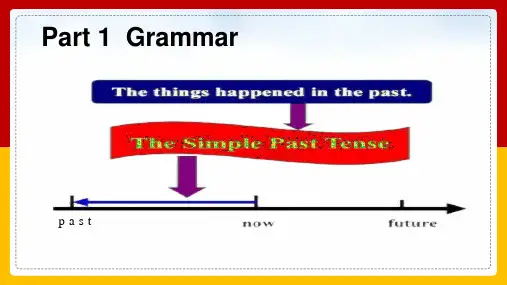
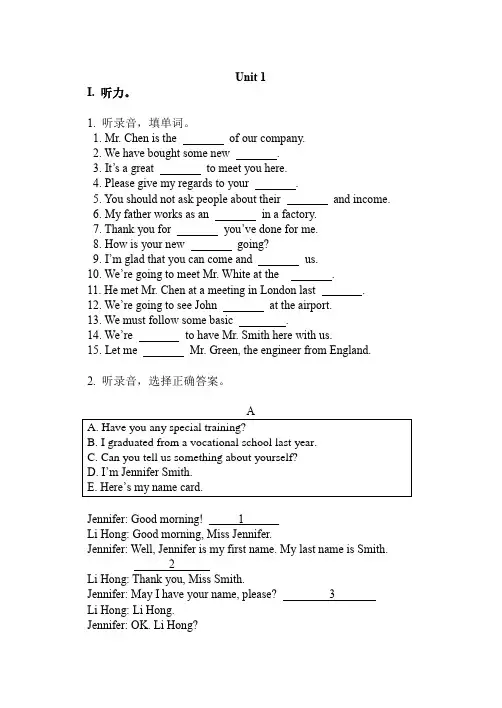
Unit 1I. 听力。
1. 听录音,填单词。
1. Mr. Chen is the of our company.2. We have bought some new .3. It’s a great to meet you here.4. Please give my regards to your .5. You should not ask people about their and income.6. My father works as an in a factory.7. Thank you for you’ve done for me.8. How is your new going?9. I’m glad that you can come and us.10. We’re going to meet Mr. White at the .11. He met Mr. Chen at a meeting in London last .12. We’re going to see John at the airport.13. We must follow some basic .14. We’re to have Mr. Smith here with us.15. Let me Mr. Green, the engineer from England. 2. 听录音,选择正确答案。
Jennifer: Good morning! 1Li Hong: Good morning, Miss Jennifer.Jennifer: Well, Jennifer is my first name. My last name is Smith.2Li Hong: Thank you, Miss Smith.Jennifer: May I have your name, please? 3Li Hong: Li Hong.Jennifer: OK. Li Hong?Li Hong: I’m nineteen and now I’m a bank clerk. But I want to be a secretary.Jennifer: I see. 4Li Hong: Yes, 5Jennifer: That’s fine. Thank you. We’ll let you know our decision later.J : What are you going to do after leaving school?D: I am thinking about becoming a guide. I would like to explore strange things.J : 1D: Of course, I do. 2J : That’s good. You seem to be good at spoken English. Is that right? D: Just so-so. I’ll try to learn it better. 3J : Maybe I’ll be a P.E. teacher. 4D: 53. 听录音,给下面句子排序。
Unit 1TravelWords and Expressionsagency /ˈeɪdʒənsi/ n. 代理公司avoid /əˈvɔɪd/ v. 避免comfortable /ˈkʌmftəbl/ adj. 令人舒服的cover /ˈkʌvə(r)/ v. 覆盖daily /ˈdeɪli/ adj. 每天的devotion /dɪˈvəʊʃn/ n. 敬业;付出discover /dɪˈskʌvə(r)/ v. 发现;找到double /ˈdʌbl/ adj. 双的dynasty /ˈdɪnəsti/ n. 朝代Egypt /ˈiːdʒɪpt/ n. 埃及ethnic /ˈeθnɪk/ adj. 民族的eventually /ɪˈventʃuəli/ adv. 最终experience /ɪkˈspɪərɪəns/ v. 感受;经历France /ˈfrɑːns/ n. 法国geographer /dʒiˈɒɡrəfə(r)/ n. 地理学家hardship /ˈhɑːdʃɪp/ n. 困苦Italy /ˈɪtəlɪ/ n. 意大利journey /ˈdʒɜːni/ n. 旅行local /ˈləʊkl/ adj. 当地的luggage /ˈlʌɡɪdʒ/ n. 行李major /ˈmeɪdʒə(r)/ adj. 主要的marvelous /ˈmɑːvələs/ adj. 了不起的national /ˈnæʃnəl/ adj. 全国的option/ˈɒpʃn/ n. 选择product /ˈprɒdʌkt/ n. 产品quit /kwɪt/ v. 放弃record /rɪˈkɔːd/ v. 记录reservation /ˌrezəˈveɪʃn/ n. 预订Shangri-La /ˌʃæŋɡri ˈlɑː/ n. 香格里拉throughout /θruːˈaʊt/ prep. 遍及;到处ticket /ˈtɪkɪt/ n. 入场券;票travel /ˈtrævl/ n. 旅行unique /juˈniːk/ adj. 独特的;唯一的vegetation /ˌvedʒəˈteɪʃn/ n. 植被well-known /ˌwel ˈnəʊn/ adj. 著名的all sorts of 各种各样的be famous for 因……知名due to 因为;应归于give up 放弃pass through 穿过;通过scenic spot 景点set off 出发take care of 照顾;注意Listening and SpeakingClerk: Good morning, Garden Hotel Room Reservation. May I help you?Guest: I’m calling from Paris. I’d like to book a non-smoking double room from October 2nd to 5th, please. My name’s Tom Wilson.Clerk: I’m sorry, Mr Wilson. We are fully booked for the 5th, but I can give you a room from the 1st to the 4th. Is that OK?Guest: That’s all right. By the way, what’s the room rate?Clerk: 380 yuan a night.Guest: Okay.Clerk: What time will you arrive, Sir?Guest: Around 6 in the evening.Clerk: Thanks. We are looking forward to seeing you on the 1st.参考译文:职员:早上好,花园酒店预订室。
第二册第一单元一、单词1.滑雪v 山n2.海滩n 乘帆航行v3.滑冰v 假期n4.精彩的adj 父亲或母亲n5.出行旅行n 家 ,家庭6.有趣的adj 事业 n7.日常的n 返回 v8.滑到 v 犹豫 n9.典型的 adj 家庭主妇 n10.家庭杂物 n 自愿 v11.火腿 n第二单元一、单词1.电影 n 国际互联网 n2.体育馆 n 卡通片 n3.流行音乐勇敢的 adj4.伶俐的 adj 特别的 adj5.轻松的,放松的 adj. 动人的,感人的 adj6.爵士乐 n 动作电影7.恐怖电影喜剧 n8.脱口秀度过 n9.摇滚乐 n 乐队 n10.乡村音乐租用 v11.订购 v 更喜欢 v12.保持 v二、短语,句子1.你觉得电影咋样?2.在那时3.我邀请朋友一起看电影。
4.我一小时又一小时的坐在电脑前。
5.总是坐在一台机器前是浪费时间的。
6.你上周末做了什么特别的事吗?7.没什么特别的。
8.你以前喜欢什么类型的音乐?9.我曾喜欢爵士乐。
10.你过去喜欢什么类型的电影?11.我曾喜欢动作电影。
12.你通常是怎么过周末的?四.用动词的适当形式填空.cook, stay, say, tell, visit, come, think, take, be, eat1Last Sunday it was snowy. Maria 1 at home. Her cousin Cara 2 tovisit her. She came back from Beijing. She 3 Maria something about her vacation."It was pretty good," she said. Cara 4 the Palace Museum andthe Great Wall. She 5 a lot of photos.It was lunch time. Maria's parents 6 not at home. They decided to cook by themselves. Maria 7 noodles with some tomatoes and pepper (辣椒). After Cara 8 up the noodles, she said slowly, “I think it isdelicious!”But Maria 9 the food was too bad. She 10 ,“Cara, thank you, but I put too much pepper into it.第三单元一、单词1.有创造力的 adj 友好的,直爽的 adj2.自信的 adj 助手 n3.打字员 n 出纳员 n4.幼儿园 n 面试 n&v5.销售,经销 n 毕业 v6.交流 n 流利的 adj7.申请人 n 更有资格;更胜任 v8.张贴 v 广告,公告 n9.简历 n 尽早,尽快10.空闲时间 n 集体自由讨论 v二、短语,句子1.能介绍一下自己吗?2.我在一年公司兼职销售员两年了。
宁德职业技术学院教学过程与内容:Ⅰ. Greeting Ⅱ. PreviewHave a comment on Ss ’ compositions. Pick out some good examples and get the Ss to read them aloud. After reading, ask some questions.(设计意图:教师对于上一课时的学生作文进行讲评,能让学生明确并及时订正自己的差错。
对于优秀作文的肯定及在全班的示范朗读,更能激发学生的自豪感,从而更主动积极地完成作业。
在朗读前,明确任务,听后要回答问题。
这样既能让听的同学更集中注意力,也有意识地培养了大家尊重他人的品质。
) Ⅲ. Lead-inTell the Ss the basic structure of the Past Tense. Ask the Ss if they know the past forms of verbs. Bb: 一般过去时: 动词的过去式(设计意图:在学生作文朗读结束后,教师告诉学生,作文中大家用来描述过去的经历要使用一般过去时。
在之前的听说课和阅读写作课中,学生们实际上已经在运用这一时态。
因此,教师在这里开门见山地提出了本课时要解决的问题。
而问题的提出:什么是动词的过去式?即在下一步骤中马上得到解决。
) Ⅳ. Contents ’ presentation Language in Use1. Game: Get the Ss to put the words into the right envelope.played danced studied stopped went cried came did read returned replied listened watched chatted had enjoyed cooked stayed gave slipped counted asked sent arrived started was were(设计意图:这一游戏要求学生按照已给的例子,把其他的单词放进正确的信封中。
中职英语语文版(2023)基础模块2 Unit 1 The Spring Festival Listening and Reading 教学设计(表格式)Unit 1 The Spring FestivalTeaching plan---listening and reading课程Unit 1 The Spring Festival 建议学时About 4教学目标1. Teachers help and train students to be able to narrate activities during the Spring Festival in English, and enable students to exchange some customs and experiences during the Spring Festival; 2. Guide students to deepen their love for traditional Chinese culture by understanding the story of "Nian"; 3. Assist students in mastering and understanding the basic structure of simple sentences; 4. Provide students with the opportunity to practice in a group of two and explore learning in a group of many, establish an independent learning environment, and cultivate students' good habits of Cooperative learning and inquiry learning.教学重点重点词汇和短语dumpling, lantern, couplets, firework, celebrate, relatives, tradition, encourage, Gala; temple fair, lantern show, lucky money, lunar month, take part in, look forward to, be prepared for, encourage sb. to do sth., make one’s decision, learn from重点句型How was your Spring Festival What did you do (during the Spring Festival) They encouraged me to... It was interesting and wonderful.重点语法 1. Sentence components 2. The Five Basic Structures of Simple Sentences教法与学法 1. Group Cooperative learning method 2. Task based teaching method 3. Competitive Incentive Learning Method 4. Autonomous learning method教学手段PPT、Mp3教学内容教学设计活动1 1. Teachers can first inspire students to try reading out the given questions and six verb phrases: visit relatives or friends, hang up red lands, put up couplets, have a get to another, make Chinese dumplings, get lucky money. 2. When students have difficulties or obstacles in pronunciation, teachers should provide timely help and support, such as distinguishing syllables or pointing out the same sound, such as hang and lanterns. In order to deepen students' understanding of phrases, teachers can release pictures on the presentation (PPT) and quickly point to a certain picture. Please ask all students who can speak to stand up and say it together, and see which group stands up and reads more. 3. After the students have basically mastered the pronunciation, the teacher asks them to work in pairs to conduct a question and answeractivity, requiring them to answer the questions in complete sentences.4.Finally, a simple sentence pattern can be used to answer the question:I got lucky money from During the answer process, as it involves events that occurred during the previous Spring Festival, students are reminded to pay attention to the use of the past tense of verbs.活动2 1.Before students start practicing in pairs, the teacher leads them to read the questions several times and then asks in a probing tone: Do you understand this sentence Who can tell us When asked: Where did you celebrate the last Spring Festival Teachers can choose Interrogative to inspire students: In Beijing or Shanghai At your home or in your grandparents' home When teachers explain why we should keep the tradition of celebrating the Spring Festival, they should provide some phrases or sentences to help students understand the problem and expand their knowledge, such as: because farmers need a good rest, drive away the dangerous animals or bad people, good wish for the coming new year, starting of the spring, and so on. 2.Is the Spring Festival holiday one of your favorite holidays You can also review some other festivals, such as May Day, the Dragon boat Festival, the Mid-autumn Day, National Day, and even Children's Day. 3. The second question is that the teacher can have each student ask three different classmates the same question. 4. Third question, the teacher provides phrases and sentences to help students organize a few sentencestogether, forming a small paragraph, and allowing students to proficiently read it out. 5. The teacher organizes all students to practice Q&A in pairs, and conducts inspections, supervision, and guidance. The third question can also stimulate students' thinking and write some good ideas and ideas on the blackboard.Part I Listening 1.Before playing the listening audio, first have the students look at the pictures and ask: Do you know "Guonian" What do you do during the Spring Festival When does it start and end Wait for a question. Students may only be able to answer some of the questions, and teachers should remind students to listen carefully, be patient, and pay attention to capturing the details in the questions. At the same time, provide several key phrases: get togethers, relationships, Lunar month, the Lantern Festival. 2. Play the listening materials and complete the exercise. 3. Play the listening again and check and correct the answers. 4. The teacher asked the students to check the answers and read out the complete five practice sentences.Part II Reading At the beginning of the reading activity, it is necessary for the teacher to lead the students to read the text aloud 2-3 times. Teachers can provide several discourse related questions for students to ask and answer each other in order to achieve comprehension. You can also give some time for students to work together and ask each other key or difficult questions in the text. The analysis of key and difficultpoints provided to teachers in the teaching reference can be selectively explained to students. Finally, the teacher proposes several key phrases or sentence patterns that students need to master based on their learning of the discourse.Part III Speaking 1. The teacher leads the students to read down the relevant phrases in the conversation first: Envelope sb. to do sth., be prepared for, Make one's decision, learn from 2. The teacher asks questions and asks students to put the learned phrases into sentences based on the conversation content, in order to achieve the purpose of using the learned content. For example: What did you do in the Spring Festival - I learned to cook dinner What did your parents tell you during the holiday - They encouraged me to work hard 3. The teacher leads the students to repeatedly read the dialogue several times, and then has the entire class work in pairs to role-play. 4. The teacher lists the questions and students choose the correct answers based on the questions.Culture Corner The Origin of Spring FestivalSelf-check After completing the content of this unit, students will conduct a self check against the language knowledge such as vocabulary and phrases in the unit to assess their mastery. Based on the test results, identify the shortcomings and learn to summarize, self-evaluate, and reflect after class. During this process, teachers can reread the listed testvocabulary and provide necessary guidance based on the actual situation, guiding students to cultivate good learning habits, and promoting the continuous improvement of students' language learning and autonomous learning abilities.。